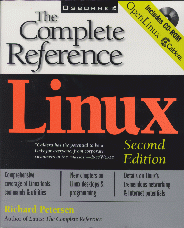

 |
 |

The book is fairly well-organized, granting a wide variety of topics a decent amount of coverage. Even with the seemingly large number of one thousand pages, however, there's a limit to how deep a reader can delve; a few subjects seem spread a bit too thinly (which is understandable, of course). The book is divided into seven parts: Introduction to Linux, Linux Operations, Networking, Shells, Editors and Utilities, Administration and Appendices. The one noticeably absent area is multimedia--the only mention of anything having to do with video, sound, graphics or gaming is a two-page procedure on installing a sound card. Perhaps multimedia will be dealt with in a future edition. Other than ignoring multimedia, however, the areas chosen seem to cover the geography of Linux fairly well.
Part I begins with an introduction to Linux, describing the history of UNIX and Linux, then gives an overview of the whole system (the shell, the file system structure, utilities, etc.). The next chapter leads the reader through the installation process. This chapter is heavily Caldera-oriented (the book comes with a Caldera OpenLinux Lite v1.2 CD), and you probably won't have much luck trying to install another distribution with these instructions. Chapter three runs through basic Linux tasks such as getting into your system through LILO, logging in and out, starting X Windows, the manual pages, etc. Chapter four tells you about window managers and desktops (such as the Caldera Desktop, with no mention of KDE or GNOME). Later versions of OpenLinux include the KDE desktop, so hopefully this will be updated soon.
Chapter five opens Part II with a guide to shell operations (redirections, pipes, scripts, etc.). Chapter six describes the Linux file structure, and the next chapter goes over file management operations such as permissions and mounting file systems.
In chapter eight, which begins Part III (Networking), one learns how to run the basic e-mail utilities such as Mail, Elm and Pine. Chapter nine goes over Usenet and newsreaders. Chapter ten introduces several Internet tools (TELNET, FTP, archie, gopher, etc.), and the Web is covered in the next chapter. In chapter twelve, the process for creating many different types of Internet servers (web servers, FTP servers, gopher servers, etc.) is described in detail. Chapter thirteen goes over remote access (UUCP, rsh, etc.).
Part IV, Shells, delves into the filters and regular expressions, the Bourne Again Shell (BASH) and the TCSH shell. Here you learn how to write your own shell scripts, as well as the arcane technicalities of each of the two major shells.
Part V covers vi and Emacs in adequate detail. Though the title of the section includes the word ``utilities'', only those two editors are covered.
Part VI, Administration, goes into systems configuration (chapter nineteen is mistakenly labeled ``Device Configuration'' in the header of each page), network administration (the basics of TCP/IP, PPP and SLIP), X Window System configuration, typesetting (TeX, LaTeX, Ghostscript), the standard Linux C compilers and libraries (gcc, g++ and gdb), Perl, Tcl/Tk, Expect and gawk.
The last and seventh part is just a compilation of appendices. The first lists hardware parameters that may be necessary to pass to the kernel at boot time, such as those for CD-ROM IRQs and other sometimes-annoying settings that don't properly autodetect. The second lists all the software packages that come with the OpenLinux CD, and the third lists the video cards supported by the X Window System.
Apparently, the book was published before it was thoroughly proofread--it is littered with glaring typographical and grammatical errors, misspellings and repetitions (for example, some text is repeated later on in the same chapter, almost word for word). Linus Torvalds' name is repeatedly spelled without the final ``s'', and '/dev/cua1' is used as a plural. Given extensive proofreading by an editor with a sharp eye, and adding a section on multimedia, the book could become a shining jewel, but in its current state it isn't worth the price of $50 US.

Ben Crowder is a young Linux aficionado living in Utah. In addition to fiddling with the insides of computers, Ben enjoys reading, writing and music. He can be reached at mlcrowd@enol.com.